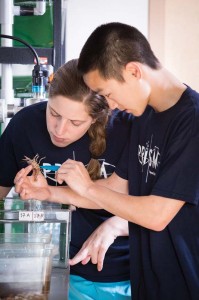Students in research program explore topics from anxiety disorders to invasive crayfish
If you shoot a window made of self-healing thermoplastic, the hole from the bullet heals itself almost instantly with an airtight seal. “The reason why is poorly understood,” said Longwood physics professor Dr. Kenneth Pestka II.
‘The opportunity to do research and get one-on-one interaction is a game-changer for graduate school and careers.’
— DR. CHRISTOPHER LABOSIER, Assistant Professor of Environmental Sciences

Patricia Hale ’16 and James Wilson ’16 examine a crayfish in their PRISM project.
Pestka and Jonathan Buckley ’16, a physics major from Round Hill, soon might know more about this phenomenon, which in recent years has been studied by NASA and other researchers. In a project in the Perspectives on Research in Science and Mathematics (PRISM) program this summer, the pair are using acoustic and ultrasonic spectroscopy to study the role of sound in the properties of these materials.
“If we can understand their healing behavior better, it may lead to better design and applications,” said Pestka.
This is the third summer for PRISM, which pairs students (who receive a $3,500 stipend and room and board) and faculty in an intensive eight-week research partnership.
The STEM-based projects, many of which are a continuation of student-involved research, reflect Longwood’s commitment to providing research opportunities to undergraduates.
“PRISM is a great opportunity for faculty and an even better opportunity for students,” said Dr. Christopher Labosier, assistant professor of environmental sciences, who is studying how climatology affects the
geospatial patterns of wildfires with Daniel Schimoler ’16, an integrated environmental sciences major from Chantilly.
“The opportunity to do research and get one-on-one interaction is a game-changer for graduate school and careers. Students often pick up skills that are hard to acquire in a classroom setting.”
The other PRISM projects are:
- The relationship, if any, between “academic entitlement” (high academic expectations, absent personal responsibility for that success) and academic performance: Dr. Sarai Blincoe, assistant professor of psychology, and Gina D’Orazio ’17, psychology major from Moseley.
- Alternative therapies in treating and preventing anxiety disorders, as well as measuring stress hormones including cortisol: Dr. Catherine Franssen, assistant professor of psychology, and Ri’Shawn Bassette ’17,
psychology and communication studies major from Hampton. - Designing a real-time control device to optimize stormwater management and waterconservation
benefits of a rainwater harvesting system: Dr. Kathy DeBusk Gee, assistant professor of environmental sciences, and Rachel Lombardi ’16, integrated environmental sciences major from Marlton, N.J. - The potential impacts of invasive crayfish on native crayfish: Dr. Sujan Henkanaththegedara,
assistant professor of biology, and Patricia Hale ’16, integrated environmental sciences major from Bedford, and JamesWilson ’16, biology major from Roanoke. - Tracking 3D flight paths and energy use in wild birds: Dr. Brandon Jackson, assistant professor of biology, and Alexon Munson-Catt ’16, biology major from Virginia Beach.
- The effects of increasing dissolved organic carbon concentration on the foraging efficiency and diet selectivity of planktiverous fish predators preying on zooplankton: Dr. Dina Leech, assistant professor of
biology, and Nicholas Ravagli ’16, biology major from Pamplin. - What is taught, and how, in Math 171, a widely taught statistics course, as well as the effect of those factors on academic performance in a sequel course: Dr. Leah Shilling-Traina, assistant professor of
mathematics education, and Deborah Bray ’16, mathematics major from Mechanicsville. - The electronic properties of molecules in electronic devices: Dr. Benjamin Topham, assistant professor of chemistry, and Sam King ’16, chemistry major from Herndon.
- Advanced topics in Lie theory through linear algebra: Dr. ThomasWears, assistant professor of mathematics, and SabrinaWalker 17, mathematics major and member of the Cormier Honors College from Cullen.
- Designing a unique second-semester organic chemistry course that incorporates the sequential synthesis of brominated paraben and carries it through antimicrobial analysis: Dr. Andrew Yeagley, assistant professor of chemistry, and Shelby Furman ’16, chemistry major from Stafford, and Hailey Kintz ’17, chemistry and biology major from Sterling.
—Kent Booty
